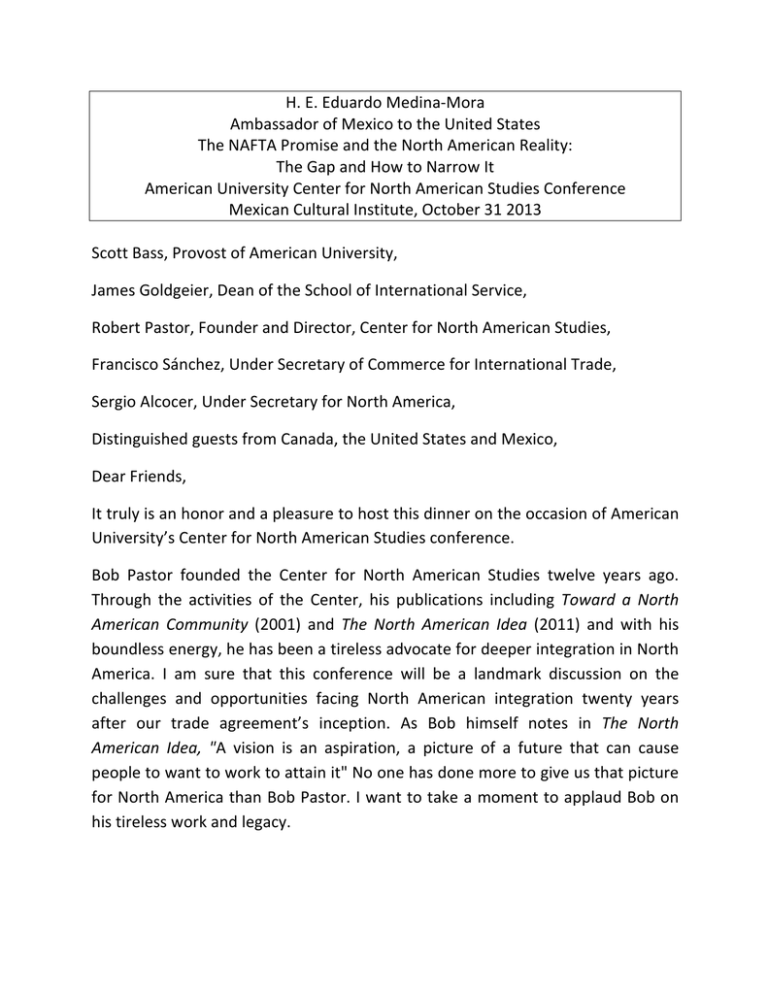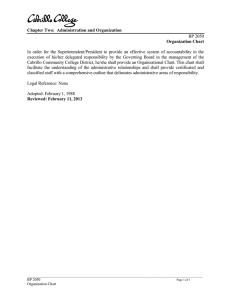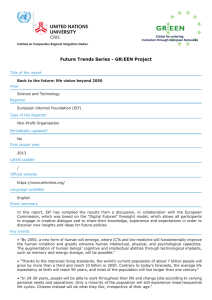Document 13679318
advertisement

H. E. Eduardo Medina-­‐Mora Ambassador of Mexico to the United States The NAFTA Promise and the North American Reality: The Gap and How to Narrow It American University Center for North American Studies Conference Mexican Cultural Institute, October 31 2013 Scott Bass, Provost of American University, James Goldgeier, Dean of the School of International Service, Robert Pastor, Founder and Director, Center for North American Studies, Francisco Sánchez, Under Secretary of Commerce for International Trade, Sergio Alcocer, Under Secretary for North America, Distinguished guests from Canada, the United States and Mexico, Dear Friends, It truly is an honor and a pleasure to host this dinner on the occasion of American University’s Center for North American Studies conference. Bob Pastor founded the Center for North American Studies twelve years ago. Through the activities of the Center, his publications including Toward a North American Community (2001) and The North American Idea (2011) and with his boundless energy, he has been a tireless advocate for deeper integration in North America. I am sure that this conference will be a landmark discussion on the challenges and opportunities facing North American integration twenty years after our trade agreement’s inception. As Bob himself notes in The North American Idea, "A vision is an aspiration, a picture of a future that can cause people to want to work to attain it" No one has done more to give us that picture for North America than Bob Pastor. I want to take a moment to applaud Bob on his tireless work and legacy. Dear friends, I have been traveling intensely and will be doing so throughout the end of the year. My destinations? Atlanta, Phoenix, San Jose, Dallas, among others. But today, I am going to embark on a different kind of trip: I am going to time-­‐travel and I hope you will be willing to get in the rhetorical DeLorean with me for a moment and go “Back to the Future”. Let’s imagine this is 2050. A future in which we take holidays on distant planets and we remember mobile phones as archaic technology. We have chips implanted in our eyes that allow us to integrate technology into our every movement. The initial promise of the information era has been realized to the fullest and developments in science and technology have impacted our way of life worldwide. Demographics are key to understanding where we are in 2050. In general terms, fertility rates and the number of young people have declined while the number of people over 65 has increased dramatically. Total population growth is seen mostly in India, certain areas of Asia and the Middle East/North Africa regions. As the UN predicted, today, in 2050, India is the most populated country in the world with 1.6 billion inhabitants. However, its estimate of 1.3 billion people in China was off the mark, given that China maintained the same demographic trends that were prevalent in the early 21st Century, and ended up with maybe 850 million inhabitants in 2050. China´s one-­‐child policy has translated into a slowdown in working-­‐age population, and its deteriorating demographics have trimmed its annual economic growth rate. By 2032, 31 per cent of the world’s population over the age of 64 was in China. Therefore, China grew old before it became rich. (PAUSE) In 2050, the North American region has 602 million inhabitants -­‐6.3% of the total world population-­‐. Mexico and the US, though, have a lower dependency ratio than China in 2050 -­‐35.4 for the US and 31.3 for Mexico. In any case, the demographics in North America, as in other prosperous regions, have required sustained efforts to achieve voluntary, safe, legal and orderly migration from other parts of the world. The world economy has also gone through some interesting changes. PricewaterhouseCoopers was right with their 2013 prediction that in 2050, the five largest economies in the world are China, the United States, India, Brazil, and Japan. Mexico is the 7th largest economy in the world in 2050 after Russia. The US and Canada are the top two countries in the world in 2050 in terms of GDP per capita, while Mexico is the top Latin American country. With regard to energy, in its Energy Outlook to 2040 ExxonMobil estimated correctly that by 2020, North America would become a net natural gas exporter and a net exporter of oil around 2030. In 2050, North America has proven it has all the necessary energy resources to fuel its economic growth for a long time. Reliable and affordable energy has been and will continue to be a key component in ensuring a competitive North American manufacturing base. In contrast, Asia and Europe continue relying on international markets to meet their energy needs. The Transpacific Pacific Partnership and Transatlantic Trade and Investment Partnership, signed by North America as a region, have been a success. We have managed to make sense out of the rules of origin and those products branded as Made in North America are sold at a premium: we make extraordinarily innovative, quality goods at competitive prices that are valued throughout the globe. A big part of the successful economic integration of North America is, of course, people. Mexicans, Americans and Canadians understand each other better than ever. People in the region are trilingual and feel at ease doing business with each other. Educational exchanges, from students, teachers and researchers alike, have been key in developing the region’s capabilities and, simultaneously, have been instrumental in overcoming stereotypes and prejudices. And we have achieved this streamlined export platform thanks to rules, procedures, infrastructure and cooperation that built on our shared vision for the future. We remember 2014 as the year in which we made a commitment to become the most competitive region in the world and 2050 is a good year to celebrate the results. We are making rockets, robots and medical devices together. We are finding cures for illnesses through biotechnology and genomic medicine and training the doctors and engineers of the future. We are investing heavily in research and development, but because we have been doing so for decades, we are far ahead of the rest of the world. Dear friends, So what is the point of going “Back to the Future” like this to see where we will be in 2050? As the physicist Michio Kaku has said, the role of science fiction is to capture people’s imagination, and to get them thinking about science. I wanted to use science fiction today to allow us to think about what we want to achieve in the next twenty, thirty and forty years. If we can find ways to see the future more clearly, we can also see what we must do to get there. The Center for North American Studies has a key role to play. While our economic achievements have been significant in the last two decades, we have gotten them not only on the basis of a set of rules laid out by governments, but mostly through the efforts of the private sector. A true commitment to growth implies a vision and a strategy, and we need to have the Center for North American Studies help us generate the knowledge to make the right decisions. In 2050, we will still be citizens of sovereign Nations and I can imagine that our relationships will not be exempt of irritants. But we will also be, in many ways, North Americans. In 2050, we will the most competitive region in the world, with the strongest combination and balance of geography, demographics, resources and capabilities. In 2050, we will look back to this day and we will see that it was the day in which we all thought it was possible. Thank you.





